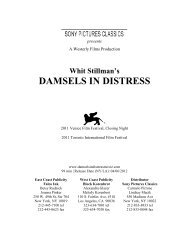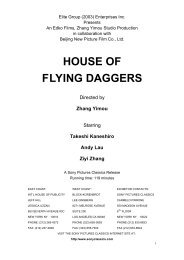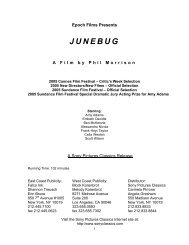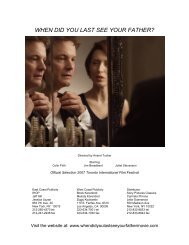Create successful ePaper yourself
Turn your PDF publications into a flip-book with our unique Google optimized e-Paper software.
IN 1996, ELECTRIC CARS BEGAN TO APPEAR ON ROADS ALL OVER CALIFORNIA.THEY WERE QUIET AND FAST, PRODUCED NO EXHAUST AND RAN WITHOUT GASOLINE.TEN YEARS LATER, THESE CARS WERE DESTROYED.“A QUIETLY SHOCKING INDICTMENT OF OURGAS-GUZZLING AUTO COMPANIES ANDTHE PETRO-POLITICIANS WHO LOVE THEM.”–KAREN DURBIN, ELLE MAGAZINETEACHER’SGUIDESUNDANCE FILM FESTIVAL 2006 • TRIBECA FILM FESTIVAL 2006WHO KILLED THE ELECTRIC CAR?
NOTE TO THE TEACHERWho Killed the Electric Car? is a powerful tool pertinent to manyacademic disciplines and adaptable to a variety of abilities,learning styles, and classroom goals. This rich, self-contained filmrequires little or no additional research on the part of the instructoror the class, but can be used as the foundation for independentstudent research. The film divides neatly into two nearly equal andindependent segments that can be shown on successive days orat different points in a unit. Both segments offer excellentdiscussion opportunities.The classroom experience of students taking courses onenvironmental science or offerings that include a unit on airquality or environmental concerns would be enriched by viewingWho Killed the Electric Car?. Courses that encourage interest inengineering and practical math applications would also benefit.The ethical and civic questions that the film explores offer a naturalconnection for teachers working in the area of civics, government,ethics, and business ethics. In many of these courses the film couldbe treated as a case study. The ethical questions raised are nearlyunlimited and a large variety of higher-level-thinking activities canbe developed from the film.Included in this packet are discussion prompts, class activities,and research suggestions.1
FILM SUMMARYWho Killed the Electric Car? is presented as a whodone-itmystery. Staying true to this genre, the filmopens with necessary background information,describes the crime committed, answering all of thewhat, where, and when questions, and then in thestyle of Sir Arthur Conan Doyle gathers the suspects forclose scrutiny, coming to a conclusion on the guilt orinnocence of each.Opening with a bit of automotive history thatestablishes the electric car as a competitive alternativeto the internal combustion engine, Who Killed theElectric Car? takes the viewer back to the beginningof the twentieth century and the dawn of theautomotive age. A straightforward explanation of whygasoline beats out electricity as the fuel of choice andhow the internal combustion engine wins dominanceconcludes the broad overview.The film then moves to the recent past with theintroduction of the California Air Resources Board andtheir 1990 decision to require that ten percent of allcars sold in California by each car manufacturer bezero-emission vehicles by the year 2003. The Dr. Jekylland Mr. Hyde response of automotive companies isrevealed; production and marketing of zero-emissioncars is detailed, a period during which thelegal and political teams of the samemanufacturers work to defeat the law thatgave birth to modern electric vehicles.While several manufacturers areincluded, the General Motors electric vehicle isfeatured. As this segment concludes, the success ofthe industry’s legal strategy is symbolized by acelebrity-studded funeral for the electric car. Thissegment is filled with factual analysis that examinesconflicting claims about emissions, practicality, costsof various fuels, and consumer demand.The second half of Who Killed the Electric Car? isSherlock Holmes at his best. The seven suspectsidentified in the first half of the film are scrutinized. Oneby one, consumers, batteries, oil companies, automanufacturers, the U.S. government, the California AirResources Board, and the newest villain, the hydrogencar, pass under the bare bulb in the inspector’sinterrogation room in an attempt to answer thequestion asked in the film’s title: Who Killed theElectric Car? At the end of each segment thefeatured suspect is judged as guilty or innocent.The film ends on a positive note, recognizing a grassrootsmovement that envisions cleaner air and energyindependence. In a John Kennedy-style appeal, thefilm claims that those who solve our energyconundrum will be those that “change the world.”2
SELECTED SCENES FOR CLASSROOM REVIEW1:19Two million new cars are sold inCalifornia each year.19:40Television advertisement for G.M.’selectric car.2:55Cheap oil supports the combustionengine over the electric car.21:21Introduce Dr. Alan Lloyd of C.A.R.B.3:35Air quality in California:“Black cloud of death.”22:10Manufacturer’s lawsuit tooverturn emissions standards.4:32Each gallon of gasoline burned yields19 pounds of carbon dioxide.22:30President Bush endorsing hydrogentechnology in the State of the Union.4:55Introduce S. David Freeman.22:43Hydrogen Hummer and thehydrogen highway.7:40Creating demand for electric cars.23:20C.A.R.B. hearing on theemissions standards.8:50C.A.R.B. and California’szero-emission policy.25:30C.A.R.B. vote to kill the standards.12:40Cost to run an electric car equalsgasoline when gas is 60 cents per gallon.26:15Manufacturers start to collectthe electric cars.14:10Californians Against UtilityCompany Abuse27:35“Save the electric car” campaign,including the mock funeral.16:10G.M. claims to have built electric carsaccording to demand.29:30Last EV1 collected.19:10Marketing; How far, how fast,how much?31:20EV1s in a G.M. lot.3
33:20G.M. spokesperson explains thefate of the collected EV1s.50:36Suspect: Car Manufacturers35:30PBS at the car crusher.56:20Suspect: Government36:58S. David Freeman, “We’re up againstmost of the money in the world.”1:03:57Suspect: C.A.R.B.37:15Vigil for the EV1s.1:07:02Suspect: Hydrogen Fuel Cell38:40Would you buy one of these electriccars? Display check for 1.9 milliondollars offered to G.M.39:20“Who controls the future?He who has the biggest club.”1:11:08President Bush at a hydrogenfilling station.1:15:05Last cars moved.39:34Scene from Naked Gun 2 1 /2:The Smell of Fear.1:18:52Automotive Museum40:25List of suspects.1:20:30Verdicts.40:58Suspect: Consumers1:22:32“The fight about the electric car wasquite simply a fight about the future.”43:20Suspect: Batteries46:38Suspect: Oil Companies41:23:58Introduce James Woolsey andPlug In America.1:27:19“The one group of people that stepsup to take it on is the group that willchange the world.”
DISCUSSION PROMPTSThese prompts can be used for full-class discussion, small group conversations, or adapted for use as writingassignments of varying length and detail.• What compromises related to cars and transportation are you willing to make to preserve and improve airquality? Brainstorm possibilities and then discuss each one, focusing on the average consumer.• What one assertion in the film do you disagree with? Why?• What one assertion in the film troubles you the most? Why?• In your own words, explain why the car manufacturers collected and destroyed the electric vehicles.• Did government serve the people in the case of electric cars? Why?• Does government have the right to tell companies what to manufacture? Why?• How important an issue is our nation’s dependence on oil? Explain.• Do you agree that those who solve the energy question will change the world? Explain.• Should the world oil supply be divided evenly according to population, given to those able to paythe highest price, or reserved for developing nations? Explain your opinion.• Is it acceptable for a nation to use oil as a weapon? Why/why not?• Would you characterize each of the following as a good citizen or a bad citizen? Why?-The oil companies-The automobile companies-U.S. consumers-Scientists researching hydrogen fuel-The citizens trying to save the electric car• Is energy a national security issue?Why/how? Explain.• How is the use of hydrogen as a fuelrelated to the reemergence of nuclear power?• Does drilling for more oil in thepristine wilderness make sense?Why/why not?• Given the information provided in thefilm, do you believe electric cars are areasonable alternative to combustionengines? Why/why not?• Given the information provided in thefilm, do you believe you will be able tobuy a hydrogen-powered car in thenext 10 years? 20 years? Ever?Why/why not?5
MOCK COURTChoose defense and prosecution teams for each of the seven defendants identified in the film. Have the teamsprepare for a mock trial using the information in the film and if desired, additional research. Stage a trial with ajury that has not seen the film.Roles:Judge: Acts as presiding officer maintaining order, resolving conflicts, and charging the jury.Prosecution team: Presents evidence against the named defendant using witnesses, charts, graphs, andphysical evidence. The team would also cross-examine defense witnesses. The prosecution’s job is to provebeyond a reasonable doubt the guilt of the defendant.Defense team: Presents evidence that rebuts the prosecution’s view and may suggest alternativeperpetrators. The defense may use witnesses, charts, graphs, and physical evidence. The team would alsocross-examine prosecution witnesses. The defense’s job is to create reasonable doubt as to the guilt of thedefendant.This activity can be used as an alternative assessment of student knowledge while also building criticalthinking and oral presentation skills.6
COMMON GOODOpen the activity by reading the paragraph below. Allow for a few minutes of general comment on the conceptof the “common good” and the claim by then G.M. president Charles E. Wilson:What’s good for the country is good for General Motors and vice versa.The preamble to the United States Constitution opens with the words: “We the People of the UnitedStates, in Order to form a more perfect Union, establish Justice, insure domestic Tranquility, provide for thecommon defense, promote the general Welfare, and secure the Blessings of Liberty to ourselves and ourPosterity, do ordain and establish this Constitution for the United States of America.” These words imply acommon interest that is shared by citizens and government, a concept often referred to as the “commongood.” In 1953, the then president of General Motors, Charles E. Wilson, was nominated by PresidentDwight Eisenhower to serve as his Secretary of Defense. During Wilson’s confirmation hearings, senatorswere concerned that he would have difficulty making a decision that could hurt General Motors, a majordefense contractor, even if the decision was in the best interest of the United States. When asked thisquestion, Wilson assured senators that he could make such a decision but that he could not imagine sucha situation, “because for years I thought what was good for the country was good for General Motorsand vice versa.”Student instructionWho Killed the Electric Car? implies that the “common good” is not being served by the decision to abandonelectric vehicles and embrace hydrogen technology. Write your own definition of the “common good.” Makegroups of 3 to 5 and share these definitions. Try to agree on a group definition. Evaluate General Motors’ decisionto kill the electric car program in light of your group’s definition. Be ready to report your findings to the class. DoMr. Wilson’s thoughts from 1953 reflect the General Motors Corporation that is presented in the film? If the Senatecalled the current president of G.M. to explain the death of the electric car, imagine what he might say thatwould be quoted more than 50 years later.7
HIDDEN AGENDATeacher introductionAs a class, brainstorm about the term “hidden agenda.” When you get all the ideas on the board, make groupsof 3 to 5. In groups, have the class discuss the ideas on the board and then write a definition of “hidden agenda”that the group can agree on. As a class, share these definitions and create one working definition for the wholeclass.Have students return to their groups and discuss what “hidden agenda(s)” the following may have had. To makea claim, the group must have at least one piece of solid evidence from the film. Each group should decide whichthree of their claims are the strongest and prepare to present them to the class.Present and discuss:Automobile companies:Hidden agenda: _____________________________________________________________________________________Evidence:Oil companies:Hidden agenda: _____________________________________________________________________________________Evidence:Filmmakers:Hidden agenda: _____________________________________________________________________________________Evidence:Car companies:Hidden agenda: _____________________________________________________________________________________Evidence:Federal government:Hidden agenda: _____________________________________________________________________________________Evidence:Fans of the electric car:Hidden agenda: _____________________________________________________________________________________Evidence:C.A.R.B.:Hidden agenda: _____________________________________________________________________________________Evidence:8
WHAT IS THE ROLE OF BUSINESS?What is the role of business in a democratic/capitalist society? The complex interaction between business,government, and consumers is presented as a case study in Who Killed the Electric Car?. After viewing the film,clarify your own attitude toward the role of business, before any discussion, by using the prompts that follow.Prioritize the entire list from 1, most important, to 10, least important, and then write just a sentence or two thatexplains each ranking. Using your results, make groups that include individuals with different attitudes. While youdiscuss the movie, analyze how different views of business influence opinions about the film.______The role of business is to make a profit.______The role of business is to make a good product.______The role of business is to serve the consumer.______The role of business is to support government.______The role of business is to educate government.______The role of business is to educate consumers.______The role of business is to improve life.______The role of business is to protect the environment.______The role of business is to provide consumers with choice.______The role of business is to invent solutions to society’s problems.9
WHAT IS THE ROLE OF GOVERNMENT?What is the role of government in a democratic/capitalist society? The complex interaction between business,government, and citizens is presented as a case study in Who Killed the Electric Car?. After viewing the film,clarify your own attitude toward the role of government, before any discussion, by using the prompts that follow.Prioritize the entire list from 1, most important, to 10, least important, and then write just a sentence or two thatexplains each ranking. Using your results, make groups that include individuals with different attitudes. While youdiscuss the movie, analyze how different views of government influence opinions about the film.______The role of government is to defend the nation.______The role of government is to create a just society.______The role of government is to protect the consumer.______The role of government is to protect business.______The role of government is to regulate business.______The role of government is to educate consumers.______The role of government is to improve life for all citizens.______The role of government is to protect the environment.______The role of government is to provide consumers with choice.______The role of government is to invent solutions to society’s problems.10
MAKING THE CASEIn the second half of Who Killed the Electric Car?, each of the suspects in this mystery is held up to scrutiny.Acting as an unbiased detective, develop a list of the evidence offered for guilt and the evidence that indicatesinnocence. In groups or as a class, use these evidence lists as the basis for a debate that leads to a vote on eachsuspect.The suspect___________________________________________________Evidence to convictEvidence to acquit11
BRIAN DANIELS teaches history and ethics atHudson High School, Hudson, Massachusetts. He is theschool facilitator for the democratic school initiative atHudson High and an active member of the school’s FirstAmendment Schools team. He has been teaching forthirty years and holds bachelor’s degrees in history andpsychology from Boston College and a master’sdegree in critical and creative thinking from theUniversity of Massachusetts at Boston. He will becomethe Curriculum Director for English and Social Studiesgrades 6-12 in the Hudson school district in the summerof 2006. He has been published several times in theBoston Globe and has an article slated for publicationin October of 2006 in the National Social StudiesSupervisors Association magazine.A SONY PICTURES CLASSICS RELEASE ELECTRIC ENTERTAINMENT PRESENTS A DEAN DEVLIN/PLINYMINOR PRODUCTION A FILM BY CHRIS PAINE “WHO KILLED THE ELECTRIC CAR?”NARRATED BY MARTIN SHEEN EDITED BY MICHAEL KOVALENKO CHRIS A. PETERSON DIRECTOR OF PHOTOGRAPHY THADDEUS WADLEIGH ORIGINAL MUSIC BY MICHAEL BROOK CONSULTING PRODUCER ALEX GIBNEYEXECUTIVE PRODUCERS DEAN DEVLIN TAVIN MARIN TITUS RICHARD D. TITUS PRODUCED BY JESSIE DEETER WRITTEN AND DIRECTED BY CHRIS PAINEFOR BRIEF MILD LANGUAGE.WWW.WHOKILLEDTHEELECTRICCARMOVIE.COMWWW.SONYCLASSICS.COM
















